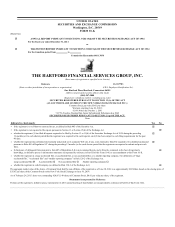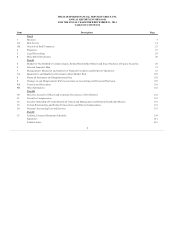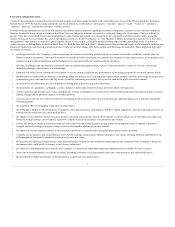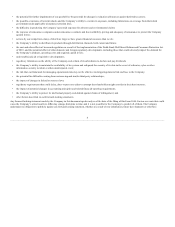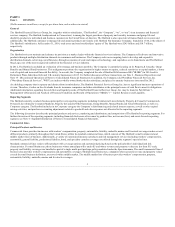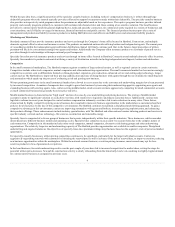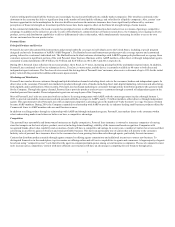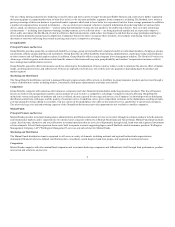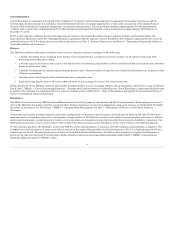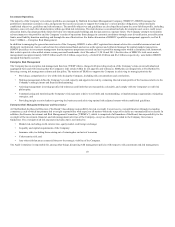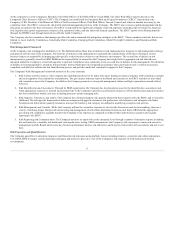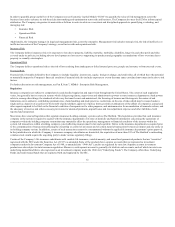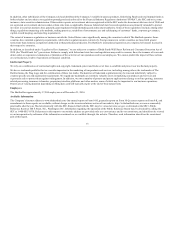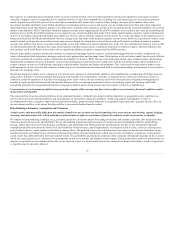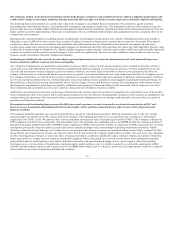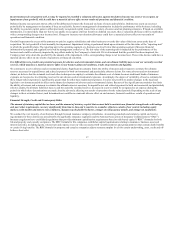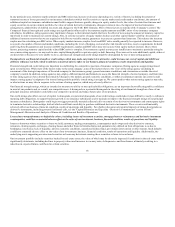The Hartford 2014 Annual Report Download - page 8
Download and view the complete annual report
Please find page 8 of the 2014 The Hartford annual report below. You can navigate through the pages in the report by either clicking on the pages listed below, or by using the keyword search tool below to find specific information within the annual report.
The use of data mining and predictive modeling is used by more and more carriers to target the most profitable business and carriers have further segmented
their pricing plans to expand market share in what they believe to be the most profitable segments. Some companies, including The Hartford, have written a
greater percentage of their new business in preferred market segments which tend to have better loss experience but also lower average premiums. In addition,
a number of companies have invested in telematics — the use of devices in insured vehicles to transmit information about driving behavior such as miles
driven, speed, acceleration, deceleration — and are using that information to price the risk and drive favorable risk selection. Also, new auto technology
advancements — including lane departure warnings, backup cameras, active collision alerts — are being deployed rapidly and are expected to improve
driver safety and reduce the likelihood of vehicle collisions. Such advancements could reduce loss frequency and therefore average premiums resulting in
lower industry premiums and increased competition. Companies that are the first to recognize these trends by, for example, introducing vehicle safety
discounts or otherwise reflecting these trends in pricing, may enjoy a competitive advantage.
Principal Products and Services
Group Benefits provides group life, accident and disability coverage, group retiree health and voluntary benefits to individual members of employer groups,
associations, affinity groups and financial institutions. Group Benefits also offers disability underwriting, administration, claims processing and reinsurance
to other insurers and self-funded employer plans. In addition, Group Benefits offers a single-company leave management solution, The Hartford Productivity
Advantage, which integrates work absence data from the insurer’s short-term and long-term group disability and workers’ compensation insurance with its
leave management administration services.
Group Benefits generally offers term insurance policies, allowing for the adjustment of rates or policy terms in order to minimize the adverse effect of market
trends, declining interest rates, and other factors. Policies are typically sold with one, two or three-year rate guarantees depending upon the product and
market segment.
Marketing and Distribution
The Group Benefits distribution network is managed through a regional sales office system, to distribute its group insurance products and services through a
variety of distribution outlets including brokers, consultants, third-party administrators and trade associations.
Competition
Group Benefits competes with numerous other insurance companies and other financial intermediaries marketing insurance products. This line of business
focuses on both its risk management expertise and economies of scale to derive a competitive advantage. Competitive factors affecting Group Benefits
include the variety and quality of products and services offered, the price quoted for coverage and services, the Company’s relationships with its third-party
distributors and private exchanges, and the quality of customer service. In addition, active price competition continues in the marketplace resulting in multi-
year rate guarantees being offered to customers. Top tier carriers in the marketplace also offer on-line and self service capabilities to agents and consumers.
The relatively large size and underwriting capacity of the Group Benefits business provides opportunities not available to smaller companies.
Principal Products and Services
Mutual Funds provides investment management, administration, distribution and related services to investors through investment products in both domestic
and international markets, and is separated into two distinct asset categories referred to as Mutual Fund funds and Talcott funds. Mutual Fund funds includes
equity, fixed income, alternative and asset allocation investment products that are actively sold primarily through retail, bank trust and registered investment
advisor channels. Talcott funds represents those assets held in separate accounts supporting legacy runoff Hartford variable insurance products. Wellington
Management Company, LLP ("Wellington Management") serves as sole sub-advisor for Mutual Funds.
Marketing and Distribution
The Mutual Funds distribution team is organized to sell across a variety of channels including national and regional broker-dealer organizations,
independent financial advisors, defined contribution plans, consultants, record keepers, bank trust groups, and registered investment advisors.
Competition
Mutual Funds competes with other mutual fund companies and investment brokerage companies and differentiates itself through fund performance, product
innovation and solutions, and service.
8

